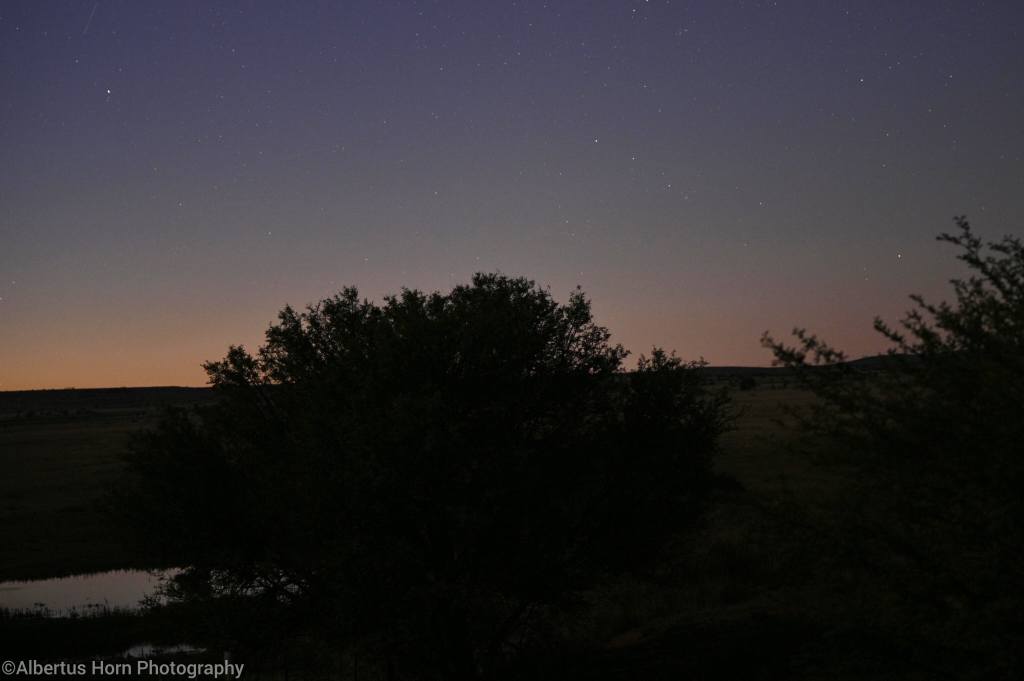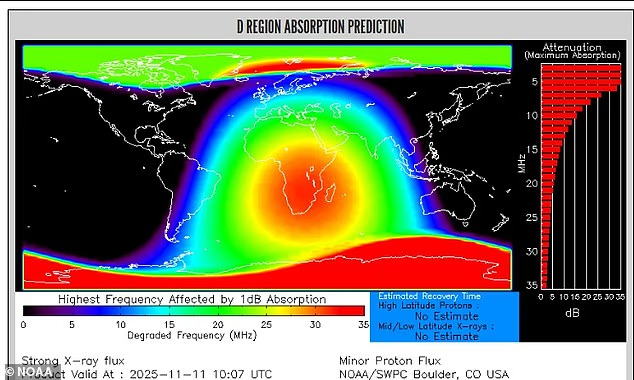No, this is not a new war - but it is an onslaught of sorts - from our local 'Yellow Dwarf' - Our Sun. A very large solar flare is on its way to Earth and NOAA scientists have produced this intensity map - and Zimbabwe is right in the middle!
So expect radio and GPS interference, mobile disruptions etc. see Dailymail - 11th Nov 2025
The sun erupted in a massive solar flare, the largest of the year, sending a wave of solar activity that could affect Earth starting on Tuesday. A powerful X5.1-class flare, capable of disrupting satellites, high-frequency radio and high-altitude flights, burst from the sun today. The flare caused a radio blackout across Europe and Africa around 5am ET, briefly affecting aviation, maritime, emergency, GPS, radar and satellite communications.
Space scientist Steph Yardley described the solar activity as 'not very common,' noting these extremely energetic particles from the sun are so strong that ground-based detectors can pick them up. 'There have been 75 recorded since 1942,' she posted on X. NOAA scientists are monitoring a possible coronal mass ejection (CME), a huge cloud of solar material and magnetic fields, moving at about 3,000 miles per second.
If it is headed for our planet, it could trigger a strong geomagnetic storm, disturbing Earth’s magnetic field overnight into Wednesday. If it is headed for Earth, it could trigger a strong geomagnetic storm, disturbing Earth’s magnetic field overnight into Wednesday. Auroras may appear as far south as Pennsylvania, Iowa, and Oregon. Power grids, GPS navigation, and HF radio communications could all be affected, NOAA shared in an alert.
Officials have issued a G3 Watch, warning that another CME from November 10 may arrive on the evening of November 11 and continue into November 12. This flare came from sunspot AR4274, which has been highly active in recent days, producing two other significant flares on November 9 and 10. Sunspots are temporary, darker patches on the sun's surface that are cooler than the surrounding areas. Officials warned that high-energy particles from the sun are triggering radiation alerts.
Passengers and crew on high-altitude polar flights may face slightly increased exposure. Satellites in low-Earth orbit, especially those flying over the poles, are vulnerable to temporary electrical disruptions. Tuesday's flare joins a recent series of powerful eruptions from the sunspot, including an X1.7-class flare on November 9 and an X1.2 flare on November 10. Solar flares are classified by their X-ray brightness, measured in a specific wavelength range by satellites. They fall into five main categories, A, B, C, M, and X, ranging from the weakest to the most powerful.
Each class represents roughly a tenfold increase in energy, with X-class flares being the strongest and capable of disrupting satellites, radio communications, and even high-altitude flights. Within each class, flares are further ranked from 1 to 9 to indicate their relative strength, with higher numbers producing more intense effects. Solar activity is expected to stay high because sunspot AR4274 is still facing Earth and is unstable. There’s a 75 percent chance of more medium (M-class) flares, which could cause brief radio blackouts, disrupt high-frequency communications and trigger minor geomagnetic storms, EarthSky reported.
There is also a 40 percent chance of another strong X-class flare, which could lead to widespread radio blackouts, interfere with satellites and GPS systems, affect power grids, and pose radiation risks to astronauts and high-altitude flights. Another sunspot, AR4276, could also produce smaller flares with minor effects as it develops.
Updated details from https://geomag.bgs.ac.uk/data_service/space_weather/alerts/update_2025-11-12.html
"We are still anticipating the arrival of another full halo CME that was associated with an X5 class solar flare on 11th November. This is expected to arrive this afternoon (12th November) and is likely to further disturb the geomagnetic field. It is possible that this will lead to a significant storm of similar magnitude to the geomagnetic storm of May 2024, which reached the maximum level of G5 on the NOAA geomagnetic storm scales, and led to aurora sightings across southern Europe."
"Assuming clear dark skies, there is an increased chance of seeing the aurora from tonight and over the next couple of days. Those in Scotland, northern England and Northern Ireland have the best chance if the weather is favourable."
GROK 4 on Southern Hemisphere observations:
Yes, due to the severe G5 geomagnetic storm triggered by multiple coronal mass ejections (CMEs) from sunspot region AR4274, the Aurora Australis (Southern Lights) has been visible unusually far north in the Southern Hemisphere, including parts of South Africa. This event began impacting Earth late on November 11 and peaked into the evening of November 12, 2025, with optimal viewing conditions from around 8 PM local time (GMT+2) southward toward clear horizons. Sightings have been reported across South Africa's coastal and inland regions, particularly in the Western Cape, Northern Cape, and potentially as far north as Gauteng and KwaZulu-Natal—areas close enough to Zimbabwe that similar visibility could occur there under dark, low-light-pollution skies (though no confirmed photos from Zimbabwe surfaced in my searches yet; locals in Harare or Bulawayo might check facing south after 9 PM).While real-time reports are still emerging (as it's early evening in southern Africa), here are confirmed photographs and sightings from South Africa last night/this evening, focusing on your request for the Southern Hemisphere (prioritizing South Africa). I've included descriptions based on available details, locations, and timestamps for your reporting:Confirmed Photos from South Africa (November 12, 2025)
- Strand, Western Cape (8:00 PM local time): A striking image captures a Stable Auroral Red Arc (SAR Arc)—a rare, reddish-purple glow caused by high-altitude oxygen emissions during intense geomagnetic activity—arching across the night sky over this coastal town east of Cape Town. The photo shows the aurora as a faint but vivid crimson band low on the southern horizon, blending with the dark ocean silhouette and distant lights of the Helderberg Mountains. Photographer: Arnold Morne Okkers. This is one of the earliest confirmed captures from this evening's display.
 Kuruman Hills, Northern Cape (4:00 AM local time, early November 12—technically last night): [SEE image by Albertus Horn -click for larger image]
Kuruman Hills, Northern Cape (4:00 AM local time, early November 12—technically last night): [SEE image by Albertus Horn -click for larger image]
An early-morning shot from this remote, dark-sky area in northern South Africa (near the Botswana border) depicts the Aurora Australis as a subtle green and red curtain shimmering southeast over the hilly landscape. The image highlights faint rays and patches visible to the naked eye under clear conditions, with the Milky Way faintly overhead for context. Photographer: Albertus Horn. This aligns with the first CME's arrival and foreshadows the stronger evening show.
Additional Reports and Potential for More Photos
- Broader sightings tonight include possible glows in Miller's Point (near Cape Town) around 4:00 AM (lingering from last night) and alerts for Pretoria/Gauteng, where locals are actively sharing updates. No widespread Zimbabwe-specific photos yet, but the storm's intensity (Kp index potentially 8–9) means it could extend there—recommend checking local astronomy groups or apps like Aurora Forecast for real-time alerts.
- For context, South African Astronomical Observatory and weather outlets like Vox Weather are live-tracking, urging viewers to look south between 9 PM and 4 AM with cameras set to long exposures (15–30 seconds, ISO 800+).

